Abstract
Rainwater harvesting has been widely discussed globally due to major concerns regarding climate change and water scarcity. This paper aims to analyse and evaluate rainwater harvesting in buildings and its relationship with the water–energy nexus. Five types of buildings were analysed: public, industrial, commercial, single-family houses, and multi-family residential buildings within the Cubatão do Norte river watershed in Joinville, Brazil. Using simulations in the Netuno programme, the potential for potable water savings was calculated. This potential was compared to the energy consumption for potable water treatment by the municipality. The average potential for potable water savings was the following: 28.18% for public buildings, 50.83% for industrial buildings, 34.12% for commercial buildings, 23.12% for single-family houses, and 18.55% for multi-family residential buildings. After analysing the energy savings for the entire watershed, the average savings were 245 kWh/day for all public sector buildings, 209 kWh/day for all industrial sector buildings, 8 kWh/day for all commercial sector buildings, 25 kWh/day for all single-family houses, and 15 kWh/day for all multi-family residential buildings. Over a year, energy savings can range from 135,426 kWh to 240,900 kWh in all the buildings studied in Joinville. Finally, further studies on the water–energy nexus are needed to make cities more resilient and sustainable in terms of using resources.
1. Introduction
The global population is expected to reach 9.3 billion by 2050 [1]. This growth will increase water demand and, consequently, the demand for other services that require water for production and distribution, such as energy and food.
Global water usage has increased sixfold in the last 100 years and continues to rise at a constant rate of 1% per year due to population growth, economic development, and climate change [1]. Therefore, reducing water use can lower energy demand in the water sector and mitigate climate change, especially if the energy source derives from fossil fuels [1].
Rainwater harvesting and use is not a new concept. Some ancient civilisations relied on rainwater harvesting as their only source of potable water [2]. This ancient practice gradually evolved into centralised public water supply systems, which have become the primary sources of water worldwide. Once populations gained access to potable water, there was a noticeable decrease in waterborne diseases and improved quality of life.
Rainwater harvesting has gained global attention due to its crucial role in addressing climate change and water scarcity. Many studies focus on analysing the advantages of rainwater harvesting as an alternative water source, such as studies conducted by [3,4,5].
Some authors have not only considered potable water savings using rainwater harvesting but have also evaluated energy consumption. Zhang et al. [6] analysed a combination of rainwater harvesting and greywater reuse to assess the potential for water and energy savings in a household in Durban, South Africa. The results showed that the integrated system of rainwater harvesting and greywater reuse was beneficial in terms of both water and energy savings, including a payback period of 4.39 years. However, this study is limited to the analysis of only one house and does not consider other types of buildings.
Vieira and Ghisi [7] evaluated the potential for energy savings in water and sewage services in Florianópolis, Brazil. The results showed that greywater reuse and rainwater harvesting accounted for 24% and 43% of total household water consumption, respectively. Regarding energy savings, rainwater harvesting was the system with the highest energy consumption (0.86 kWh/m3), while greywater reuse proved to be the most energy-efficient strategy (0.54 kWh/m3). However, this study was also limited to the analysis of houses.
Wanjiru and Xia [8] studied the water–energy nexus in South Africa. The results showed that through rainwater harvesting and greywater reuse, the potential for potable water savings reached 23.5% per month. By using both systems, energy consumption could be reduced by up to 35.7% per month. Despite these benefits, government intervention would still be necessary to support these technologies, as the system did not prove to be viable over its lifespan. However, in this article, only the residential typology was analysed.
Cureau and Ghisi [9] analysed energy savings in the water supply and sanitation system due to reduced potable water consumption in the Cachoeira River basin in Joinville. The results showed a variation from 2136.8 MWh/year in the minimum savings scenario to 8951.5 MWh/year in the maximum savings scenario. They analysed four types of buildings with four different strategies for water savings (replacement of toilets, greywater reuse, rainwater harvesting, and combination of strategies). Njepu et al. [10] examined the water–energy nexus in households using rainwater harvesting and greywater reuse. Their results indicated a 20.5% reduction in potable water consumption and energy savings of 62.54%, by analysing only houses.
Marteleira and Niza [11] analysed the water–energy nexus of rainwater harvesting on the Instituto Superior Técnico (IST) campus in Oeiras, Portugal. They concluded that rainwater harvesting on the campus is not a viable business model for the water distribution utility. However, from the customer’s perspective, it proved to be a beneficial investment with a payback period of twelve years.
Jones and Leibowicz [12] explored ways to maximise the benefits of decentralising water and energy distribution systems in Texas, USA. They analysed photovoltaic solar energy, wind energy, rainwater harvesting, and greywater reuse. Individual and group studies were conducted on scales of 32, 320, and 3200 homes. The results showed that distributed electricity and water production increased, while total costs decreased when resources and demands were aggregated at larger community scales. However, this research analysed only houses, but the positive point was the fact that it grouped the houses, which is close to the local reality.
Hong et al. [13] assessed energy consumption for water production in South Korea, considering various water supply options, including rainwater harvesting. They concluded that rainwater harvesting and greywater reuse showed higher energy intensities, requiring system size and configuration optimisation.
Jacque et al. [14] analysed water conservation measures and alternative water sources, including rainwater harvesting. They concluded that water conservation methods can significantly reduce water and energy usage in buildings. Silva et al. [15] explored the environmental, social, and economic aspects of rainwater harvesting systems, and the results showed that these systems can reduce electricity consumption and greenhouse gas emissions when compared to public/centralised water supply systems.
Considering the above, this article aims to analyse and evaluate rainwater harvesting in buildings and its relationship with the water–energy nexus, focusing on a study carried out in the Cubatão do Norte river watershed in Joinville, southern Brazil. Five types of buildings were analysed: public, industrial, commercial, single-family houses, and multi-family residential buildings, and the results can be useful for professionals to design sustainable, economical, and viable rainwater harvesting systems in terms of water and energy savings. This study helps to understand the water–energy nexus and its interconnections while also examining the impact of legislation on rainwater harvesting and potable water savings in the municipality.
2. Method
Data were obtained from buildings with an area of 250 m2 or more in the Cubatão do Norte river watershed in the municipality of Joinville. This area was defined based on Complementary Law No. 492/2017, which mandates rainwater harvesting for buildings with 250 m2 or more in Joinville [16]. The buildings were categorised by typology to verify the occurrence of the most likely frequency. Simulations were then performed regarding rainwater harvesting to assess the water–energy nexus. These simulations involve sizing the rainwater storage tanks for non-potable use, leading to potable water savings. By using rainwater, less water should be extracted from the city’s supply source, which will impact the energy usage by the utility. Figure 1 shows the flowchart illustrating this method.
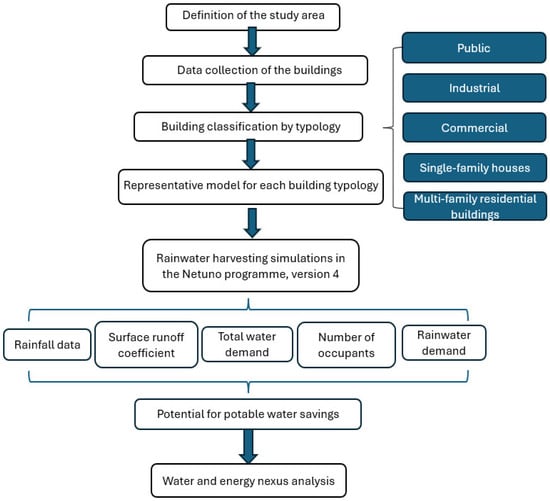
Figure 1.
Flowchart illustrating the method.
2.1. Study Area
Located in the southern region of Brazil (latitude: 26° 18′ 16′′ S and longitude: 48° 50′ 44′′ W), Joinville had an estimated population of 654,888 inhabitants in 2024 [17]. It is the most populous city in the state and is the regional hub of the northeastern region of the State of Santa Catarina. Figure 2 shows the geographical location of the municipality in Brazil.
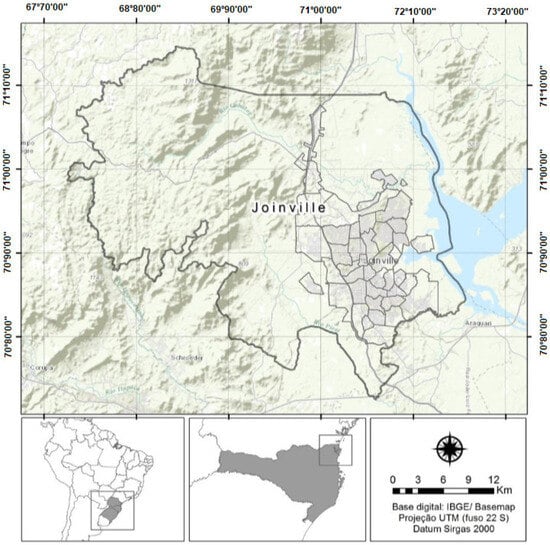
Figure 2.
Location of Joinville municipality [18].
The Cubatão do Norte river watershed is considered one of the main basins in the northeastern region of the state of Santa Catarina, located in the municipalities of Joinville (approximately 80% of the watershed) and Garuva (20%). It is the primary water contributor to Babitonga Bay [19]. The watershed has a total area of 491.67 km2 and a perimeter of 156.9 km. The neighbourhoods in Joinville that are totally included in this river watershed are Dona Francisca, Jardim Sofia, Jardim Paraíso, and the Pirabeiraba district. Rio Bonito, Bom Retiro, Vila Cubatão, and the North Industrial Zone are partially included in the basin [20]. This watershed has become the object of study as it houses the main Water Intake and Treatment Station (ETA/Cubatão), which is responsible for 77% of the water supply in Joinville [21].
Among the river basins in the Joinville region, the Cubatão do Norte river watershed has the second-highest average annual rainfall (2183 mm), as the Serra do Mar mountain range acts as a natural orographic barrier, influencing the region’s rainfall [20].
2.2. Data Collection of Buildings
The building data were provided by the Municipality of Joinville Department of Finance—SEFAZ. Buildings with floor-plan area equal to or greater than 250 m2 were selected in accordance with Complementary Law No. 492/2017 [16].
The data include the built area, land area, address, neighbourhood, and use. The data are georeferenced, meaning that the exact location of each building can be located.
2.3. Building Classification by Typology
For grouping purposes, five building typologies were selected: public, industrial, commercial, single-family houses, and multi-family residential buildings. For property tax (IPTU) purposes, buildings were also classified into other categories. Thus, the categories of services, institutions, schools, hospitals, churches, banks, health centres, municipal administration buildings, and credit cooperatives were included in the public category.
2.4. Representative Model for Each Building Typology
For each typology, a representative model was described based on the most likely occurrence for each building. The variable used was the built area because these data were provided by the local council. Based on the built area of the representative model, the roof area was estimated by simple regression, as the roof area is an essential input for the simulations in the Netuno programme.
For each typology, outliers, or inconsistent values, were excluded. To exclude these, the interquartile range (IQR) concept was used, which is the difference between the first and third quartiles, covering 50% of the data and useful for detecting outliers [22]. Values that were 1.5 times the IQR below the first quartile or above the third quartile were considered outliers, according to Cureau [23].
To verify the most likely occurrence for each typology, the data were first divided into classes. The number of classes based on the number of values for each variable was determined using Sturges’ formula, through Equation (1) [24].
where is the number of classes and is the total number of observations.
After determining the number of classes, the class interval range was defined, which is obtained by dividing the total range by the number of classes. The class interval defines the width of each class for use in a frequency table or graph. The class interval is the difference between the upper and lower limits of each class. Subsequently, the absolute frequency and relative frequency for each class were obtained. Using the frequency distribution, the built areas were classified and the percentages corresponding to each class were determined.
The class that shows the highest frequency is the modal class. The mode is the dominant value that lies between the limits of the modal class. For this class, the mode was calculated using Czuber’s formula, through Equation (2) [24].
where Mo is the sample mode, is the lower limit of the modal class, is the absolute frequency of the modal class, is the absolute frequency of the class before the modal class, is the absolute frequency of the class after the modal class, and is the range of the modal class.
The sample mode was adopted as the built area of the representative model for each building typology. After obtaining the built area of the representative model, a mathematical relationship was created through regression between the built area and the roof area for this model.
To obtain the mathematical relationship, samples of the built areas of all typologies were randomly selected, and the corresponding roof areas were estimated using Singeo (Georeferenced Municipal Information System) from Joinville, which is available on the city’s website.
The buildings selected for estimating the roof areas were chosen using simple random sampling. The population (in this case, the built areas of the buildings) was numbered from 1 to n, and then, using an electronic randomiser, the buildings were chosen for estimation [24]. The sample size, represented by the number of roofs, was determined based on the population. According to Hair Jr. [25], small samples are suitable for analysis using simple regression and are typically characterised by fewer than 30 observations.
Afterwards, scatter plots were constructed for the built area and roof area values, and the equation that best fit the scatter was identified, giving a coefficient of determination (R2) above 80%. This means that the equation explains 80% of the possible variation in the dependent variable. The roof areas are required for the simulations in the Netuno programme.
2.5. Netuno Programme Simulations
The Netuno programme is used to simulate rainwater harvesting systems. The programme’s methodology is based on behavioural models using known variables. Based on the input data, it provides results showing the relationship between the potential for potable water savings through rainwater harvesting and the water tank capacity, the volume of rainwater runoff, among others [26]. After inputting the data, simulations were performed for different rainwater demands for each building typology, considering the presence of an upper water tank. The following sections present the input data to be inserted into the Netuno programme, version 4.
Different rainwater demands were simulated for the various typologies to obtain ranges of probable potable water savings based on rainwater harvesting.
2.5.1. Rainfall Data
The rainfall data for the city of Joinville was obtained from the Cubatão Cachoeira Joinville (CCJ) Committee, which provided daily rainfall data for the municipality from January 2005 to May 2022. These data were entered into the Netuno programme for simulations of the representative models.
An initial 2 mm of rainfall was discarded according to the NBR 15527 standard recommendations [27], which suggests this exclusion to improve water quality and reduce dissolved and suspended solids.
2.5.2. Surface Runoff Coefficient
The surface runoff coefficient is a value related to the type of roof, meaning it is directly linked to the material from which the roof is made. Ribeiro and Marinoski [28] studied various types of materials used in roofs, and the results showed the values of the surface runoff coefficient as presented in Table 1. These values were adopted in this research based on the roofs observed in the building typologies.

Table 1.
Surface runoff coefficient [28].
2.5.3. Total Water Demand and Number of Occupants
For the total water demand, values were defined based on previous studies. Table 2 provides a summary of these studies for each building typology and the value considered in this research.

Table 2.
Studies on total water demand.
The daily water demand for the industrial building was considered proportionally based on the study by Mierzwa et al. [31], conducted at a metallurgical industry in Greater São Paulo. In their study, Mierzwa et al. [31] considered water demand to vary between 20 m3 and 100 m3 per day for a roof area of approximately 17,000 m2. In this study, water demand was considered to vary between 1050, 2450, and 4900 L/day, which was divided by the number of occupants to obtain the per capita demand.
The number of residents or occupants of the building was estimated based on the IBGE census (2023). For residential buildings, the average number of residents per unit was obtained. For public, commercial, and industrial buildings, the number of occupants was estimated based on the building’s use, aligning with the most likely occurrence according to Instruction Normative—IN9 from the Santa Catarina Military Fire Department [40].
2.5.4. Rainwater Demand
Regarding rainwater demand, data from previous studies were obtained for each building typology, considering non-potable demands from toilet flushing and garden taps. Table 3 provides a summary of the literature studies and the values considered in this research.

Table 3.
Studies on rainwater demand.
Rainwater demand for the industrial building was considered based on the water use of the representative building, aligned with the most likely occurrence.
2.5.5. Upper and Lower Water Tank Capacities
Simulations were conducted with various water tank capacities to size the lower water tank in the Netuno programme, which then indicated the optimal option. To determine this, the difference in the potential for potable water savings needs to be defined through rainwater harvesting. According to Cureau [24] and Custódio [45], the adopted difference in savings potential was 2%/m3.
For the upper water tank, it was defined that the capacity should be equal to the average daily rainwater demand. It was also specified that water should be pumped when the upper water tank capacity drops below 20%, to ensure there is always enough water for the system to function.
2.5.6. Water–Energy Nexus
After defining all the parameters mentioned in Section 2.5, simulations were performed in the Netuno programme. After running the simulations, the potential for potable water savings through rainwater harvesting was obtained as a percentage.
The savings generated by not capturing and treating water for non-potable purposes should result in energy savings for the utility company.
The daily potential for water savings was obtained using Equation (3):
where is the potential for water savings (L/day), is the daily water demand in the building (L/day), and is the potential for potable water savings (%).
The potential for energy savings was estimated using Equation (4).
where is the potential for electricity savings (kWh/day), is the potential for water savings in the building (m3/day), and is the electricity consumed by the utility company for water treatment and distribution (kWh/m3).
The data regarding energy consumption by the utility company for potable water treatment and distribution were obtained from the data published by the National Sanitation Information System (SNIS in Portuguese).
In the Joinville water supply system, operational energy is sourced from the free energy market, supplemented by generators that are activated when needed. In the free energy market, consumers can choose the supplier company, the terms and prices, according to their needs.
3. Results and Discussion
3.1. Representative Model
After separating the data for each typology, the outlier data, i.e., inconsistent data, were identified and excluded. Figure 3 shows the box plot for the outlier data for each building typology. Table 4 shows the percentage of outlier data that was excluded for each building typology.
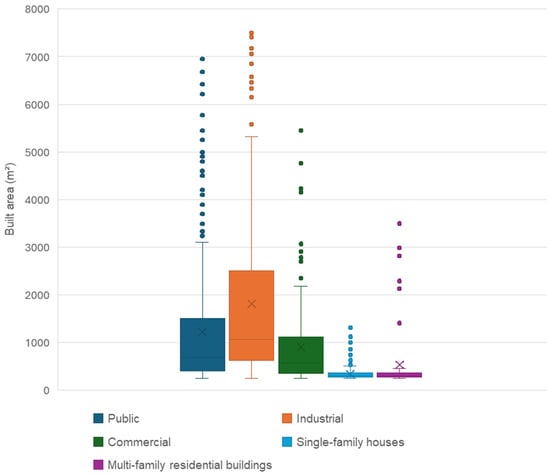
Figure 3.
Box plots identifying outlier data.

Table 4.
Percentage of outlier data excluded from each typology.
After excluding the outlier data, a frequency distribution was created in a histogram to calculate the mode of the most probable frequency. Figure 4 shows the frequency distribution for public buildings and the class with the most probable frequency, which is 47.10% (class 250 to 610.3 m2 with 130 observations).

Figure 4.
Frequency distribution for public buildings.
For the class with the most probable frequency, the mode was calculated using Equation (2), and the result was 474 m2. This value represents the built area of the representative model for public buildings. This procedure was repeated for the other building typologies, obtaining the built area values for the representative models of each typology.
After obtaining the built area, the roof areas were estimated randomly to find a mathematical relationship that would provide the roof area for the representative model. Figure 5 shows one of these estimates using Singeo version 2022. It shows the neighbourhood description, the property registration number, and the estimated projection of the building’s roof.
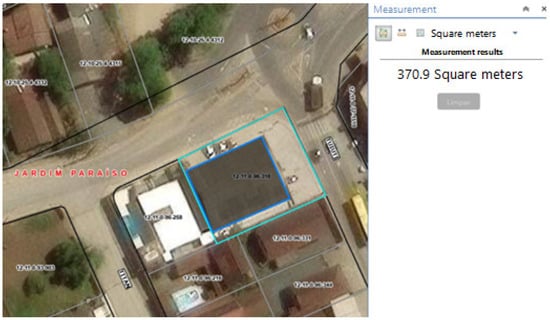
Figure 5.
Estimation of the roof area of a commercial building using Singeo.
After estimating the buildings’ roof areas, a scatter plot was created for the built area and roof area variables. The curve with the mathematical relationship indicating a coefficient of determination (R2) greater than 80% was then found. Figure 6 shows the results for public buildings.
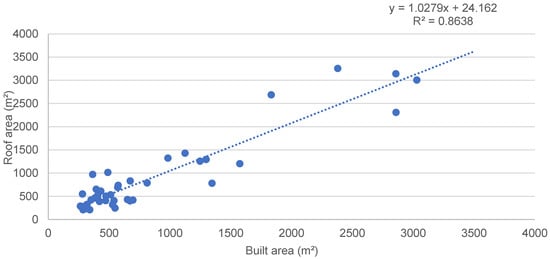
Figure 6.
Correlation between roof area and built area for public buildings.
The same procedure was repeated for the other buildings. Table 5 summarises the equations and the coefficients of determination for each building typology, where “y” represents the roof area and “x” the built area. Using these equations, the roof areas of the representative models were determined.

Table 5.
Built area, equations, coefficient of determination, and roof area for the five building typologies.
3.2. Rainwater Harvesting
3.2.1. Input Data in the Netuno Programme
For the Netuno programme simulations, the input data are summarised in Table 6. For all simulations, the upper water tank was considered, and its capacity was set equal to the average daily rainwater demand. It was also specified that water should be pumped whenever the upper water tank capacity dropped below 20%.

Table 6.
Summary of input data in the Netuno programme.
Regarding the lower water tank, simulations were requested for various capacities, and the programme was run to indicate the best capacity for each case. These capacities were specified in increments of 1000 L, as they are found easily commercially. The Netuno programme makes it possible to determine the optimal capacity of the lower rainwater tank by comparing the potential savings obtained for capacities of adjacent tanks. The ideal capacity is the one in which the increase in the savings potential of the subsequent capacity is equal to or less than the interval between drinking water savings potentials adopted [46]. The interval between the savings potential must be defined by the user, and in this article, it has been defined as 2%/m3.
To calculate the number of people in public buildings, a public building with the closest built area to the representative model (474 m2) was considered. From this area, data provided by the local council was verified to identify which building could be included in the study. A building with 472 m2 of built area was selected. After reviewing the information, it was confirmed to be the Casa Krüger, which currently serves as a tourist information centre and museum. To calculate the number of people who visit the place, the Normative Instruction—IN9 [40] from the Santa Catarina Military Fire Department was used, which calculates the occupancy for emergency exit sizing. For a building classified as a museum, IN9 [40] specifies that one person should be considered for every 3 m2 of built area.
The same procedure was adopted for the industrial building. Among the available data, an industrial building with characteristics matching the built area of the representative model (701 m2) was selected. A metallurgical industry with 700 m2 was considered to calculate the number of people. According to IN9 [40], for industrial buildings, one person should be considered for every 10 m2 of built area.
The number of users for the commercial building was also obtained from the IN9 regulation [40], where for commercial buildings, one person should be considered for every 7 m2. For single-family houses, data from the Brazilian Institute of Geography and Statistics (IBGE) were consulted. In Joinville, the average number of people per household is 2.8 [17]; therefore, three occupants per single-family home were considered. For multi-family houses, an existing building with a built area close to the representative model was considered. It was found to be a two-storey building with four flats. Therefore, three people per flat were considered for this building.
The daily per capita water demand for the industrial building was considered proportional to the study by Mierzwa et al. [31]. In this article, the variable demand of 1050, 2450, and 4900 L/day was divided by the number of users to obtain the per capita demand. These values were obtained based on the proportion of the roof area in Mierzwa et al. [31].
The percentage of rainwater demand for the industrial buildings was considered the same as for commercial and public buildings, i.e., 50%, 70%, and 80%.
3.2.2. Simulations in the Netuno Programme
Figure 7 shows the results for public buildings. The highest percentage of potable water savings is 29.6%, with an ideal lower water tank of 8000 L.
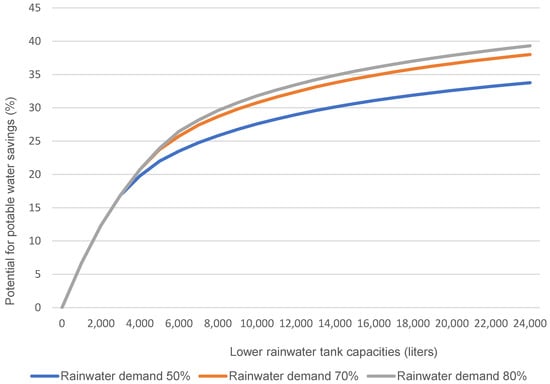
Figure 7.
Percentage of potable water savings and lower water tank capacity for public buildings with different percentages of rainwater demand.
For industrial buildings, the results obtained are shown in Figure 8. It can be observed that for the simulations carried out, varying the potable water demand and the rainwater demand, the ideal water tank capacities varied from 7000 L to 11,000 L, and the percentage of potable water savings ranged from 33.03% to 73.82%.
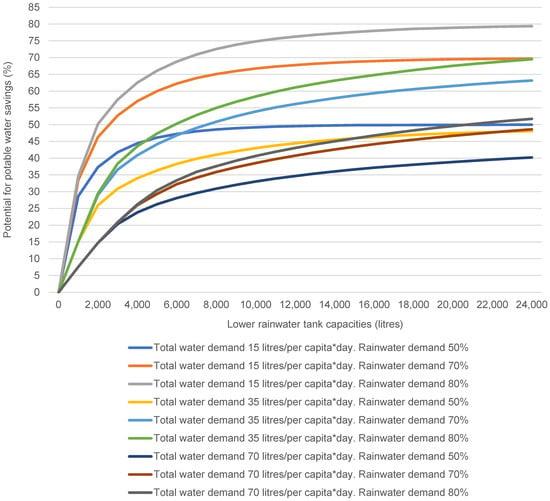
Figure 8.
Percentage of potable water savings and lower water tank capacity for industrial buildings with a variation in the percentage of rainwater demand and potable water demand.
Figure 9 shows the results for commercial buildings. The highest percentage of potable water savings was 36.58%, with an ideal lower water tank capacity of 8000 L.
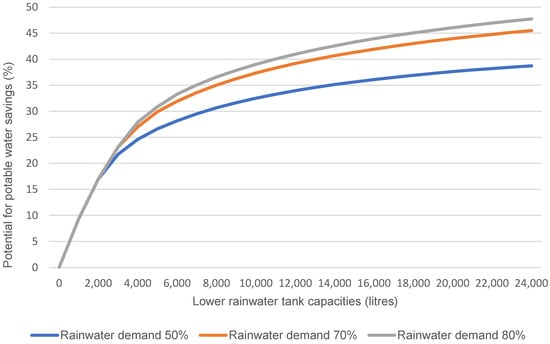
Figure 9.
Percentage of potable water savings and lower water tank capacity for commercial buildings with different rainwater demands.
Figure 10 shows the results for single-family houses. The highest percentage of potable water savings was 39.4%, with an ideal lower water tank capacity of 5000 L.
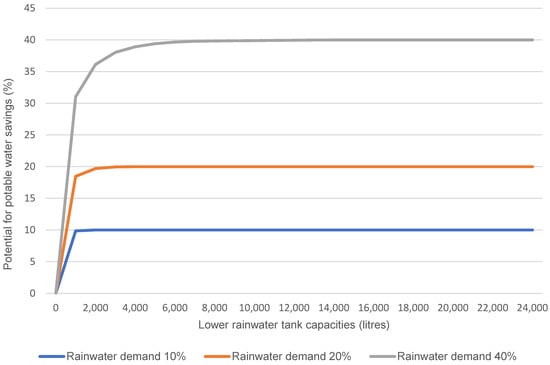
Figure 10.
Percentage of potable water savings and lower water tank capacity for single-family houses with different rainwater demands.
Figure 11 shows the results obtained for the simulation of multi-family residential buildings. The highest percentage of potable water savings was 27.83%, with an ideal lower water tank capacity of 8000 L.
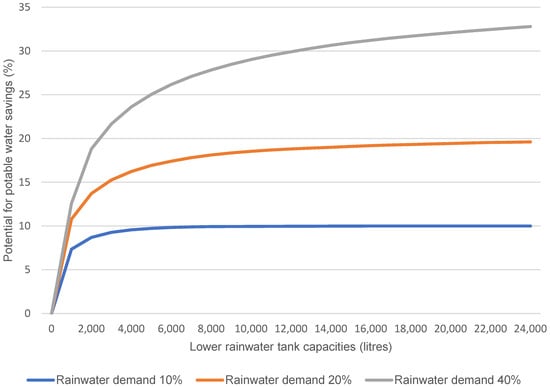
Figure 11.
Percentage of potable water savings and lower water tank capacity for multi-family residential buildings with different rainwater demands.
Figure 12 shows the range with the maximum, minimum, and average (point) of the potential for potable water savings for each building typology based on the simulations conducted. The average found for each typology was 28.18% for public buildings, 50.83% for industrial buildings, 34.12% for commercial buildings, 23.12% for single-family houses, and 18.55% for multi-family residential buildings.
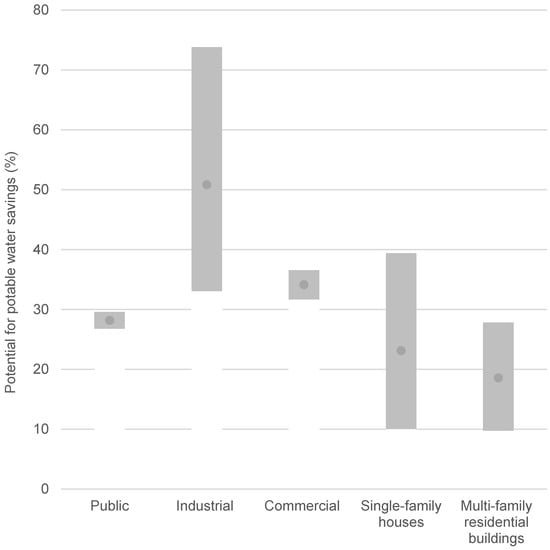
Figure 12.
Range of the potential for potable water savings for the public, industrial, commercial, single-family house, and multi-family residential buildings typologies.
The results obtained partially corroborate the study by Cureau and Ghisi [47], showing differences in the industrial typology, which was not analysed, and in the multi-family residential building typology. Cureau and Ghisi [47] analysed the reduction of potable water consumption and sewage generation adopting four different water-saving strategies, including rainwater harvesting in Joinville. The authors studied four typologies (single-family houses, multi-family residential buildings, commercial, and public) in the Cachoeira river watershed. The results showed that the average potential for potable water savings in the scenarios using rainwater harvesting was 28.1% for single-family houses, 6.3% for multi-family residential buildings, 29.5% for public buildings, and 25.4% for commercial buildings. Comparing with the results of this research, differences of less than 10% were observed, except for multi-family residential buildings, where the difference was 12.25%.
Proença et al. [48] analysed the potential for potable water savings through simulations in the Netuno programme in Florianópolis. They examined different water-saving strategies, such as dual-flush toilets, greywater reuse, and rainwater harvesting. They studied buildings in public, commercial, and residential typologies. The results of rainwater harvesting showed water savings of 20.1% for public buildings, 7.3% for commercial buildings, and they did not analyse rainwater harvesting for residential buildings because all non-potable water needs in this category were met by dual-flush toilets and greywater reuse. The study by Proença et al. [48] did not include the industrial typology. This result partially corroborates the findings of this research, as the difference in the potential for water savings for public buildings was less than 10%, but the difference for commercial buildings was 26.41%.
In the commercial typology, the results obtained corroborate those of Ghisi et al. [49], who analysed a commercial building (petrol station), where the potential for potable water savings could reach 73.0%, but it varied from 7.4% to 57.2% when considering the ideal capacities of rainwater storage tanks for each case. Other studies also show the benefits of rainwater harvesting in commercial buildings, such as those by Lani et al. [50], Matos et al. [51], Chilton et al. [52], and Gomes et al. [53].
In the industrial typology, the percentage of potable water savings varied from 33.03% to 73.82%, with an average of 50.83% for the simulations conducted. Considering the industrial typology, Mierzwa et al. [31] performed simulations for a metallurgical industry, and the potential for potable water savings reached 82%. Oliveira [54] analysed rainwater harvesting in a brewery and beverage industry. The results showed that rainwater could be used in many cleaning processes (manual and automated), steam production, refrigeration systems, among others. The author analysed all the stages that use water in the industry and proposed alternatives for potable water saving, which included rainwater harvesting and greywater reuse.
In the industrial sector, water can be used in various ways, either as part of the production process or for sanitary purposes [55]. In the production process, water can serve as a raw material, reagent, and solvent for solids, liquids, and gases, for washing and retention of materials, as a suspension vehicle, for cooling, and for steam production [56]. In many of these uses, water does not need to be potable, enabling the use of non-potable water sources such as rainwater or reclaimed water. Rainwater harvesting in industry can be applied to boiler water production, cooling systems, gas scrubbers, and as non-potable water for industrial processes. Power generation plants, oil refineries, chemical units, and metallurgical plants have benefitted from rainwater harvesting [57].
3.3. Water–Energy Nexus Analysis
According to SNIS data [58], Joinville produced and treated a water volume equal to 68,509,000 m3 in 2022. It served 613,247 inhabitants, and the electricity consumption was 34,872,300 kWh for potable water production and treatment. Thus, to produce each cubic meter of potable water, 0.509 kWh of energy was consumed.
Considering the average potential for potable water savings through rainwater harvesting for the buildings studied, Table 7 provides a summary of the results, including the potential for energy savings.

Table 7.
Summary of results for the water–energy nexus in the Cubatão do Norte river watershed.
Considering the entire Cubatão do Norte river watershed, the average energy savings obtained are 245 kWh/day for all public sector buildings, 209 kWh/day for all industrial sector buildings, 8 kWh/day for all commercial sector buildings, 25 kWh/day for all single-family houses, and 15 kWh/day for all multi-family residential buildings. Over a year, the energy savings could range from 135,426 kWh to 240,900 kWh for all buildings studied in the watershed. In view of this result, the focus of public policies should be mainly on buildings of the public typology and on the industrial typology. Although there are more single-family houses in the watershed, when analysing all the buildings, it is evident that laws, tax incentives, educational programmes and campaigns should focus first on the public sector buildings, as it was the typology that generated the greatest benefit in terms of water–energy nexus.
In 2022, the per capita energy consumption in the southern region of the country was 3084 kWh/person [59]. Therefore, with the energy savings generated by rainwater harvesting in the Cubatão do Norte river watershed, it would be possible to meet the annual consumption of 44 to 78 people.
Proença et al. [48] studied the potential for electricity savings through reduced potable water consumption in Florianópolis, Brazil. Total potable water savings of 40.2% would be achieved across the three sectors of the city (public, residential, and commercial) by combining three strategies for water consumption reduction, including rainwater harvesting. These potable water savings would reduce electricity consumption by 4.4 GWh/year in Florianópolis, representing approximately 0.5% of the city’s total electricity consumption. Other authors also highlight energy savings through rainwater harvesting, such as Wanjiru and Xia [8], Njepu et al. [10], Chiu et al. [60], Gianoli and Bhatnagar [61], Latif et al. [62], Cureau and Ghisi [9], Silva [63], and Zang et al. [64].
Finally, this research demonstrates how building use, potable water demand, and the percentage of rainwater demand directly influence water and energy savings. By running simulations of real buildings (250 m2 or larger) in the Cubatão do Norte river watershed, important data were obtained to analyse the effectiveness of legislation, as well as relevant data on the ideal capacity of water tank for each building typology.
4. Conclusions
This research aimed to analyse the water–energy nexus using rainwater harvesting with the possible decentralization of part of the water supply for non-potable use. The research was limited by the study of only one hydrographic basin in the municipality. It is suggested that future studies expand the investigation, obtaining results for the entire municipality of Joinville and that this research can also be expanded to other municipalities. In addition, it is also suggested that the payback period of rainwater harvesting facilities in each type of building be calculated.
The results showed that the average potential for potable water savings for buildings in the public sector was 28.18%, for the commercial sector, it was 34.12%, for the industrial sector, it was 50.83%, for single-family houses, it was 23.12%, and for multi-family residential buildings, it was 18.55%. When analysing the energy savings for the entire watershed, average energy savings of 245 kWh/day were obtained for all buildings in the public sector, 209 kWh/day for all buildings in the industrial sector, 8 kWh/day for all buildings in the commercial sector, 25 kWh/day for all single-family houses, and 15 kWh/day for all multi-family residential buildings. In one year, the energy savings could vary from 135,426 kWh to 240,900 kWh for all the buildings studied in the watershed. Therefore, it is essential that public policies address buildings of the public typology first, followed by the industrial typology, as they presented greater savings in the water–energy nexus.
It can be concluded that building use, potable water demand, and rainwater demand directly influence the water and energy savings of a region, and this research demonstrated this. It is essential to conduct more analyses and gain a more in-depth understanding of the water–energy nexus and its interrelations to create more resilient and sustainable cities regarding their resource use.
Author Contributions
T.M.S.O.: Writing—original draft, Methodology, Investigation, Formal analysis, Data curation, Conceptualisation. E.G.: Writing—review and editing, Supervision, Validation, Visualisation, Formal analysis. All authors have read and agreed to the published version of the manuscript.
Funding
This research received no external funding.
Data Availability Statement
Data will be made available on the request.
Conflicts of Interest
The authors declare no conflicts of interest.
References
- UNESCO. The United Nations World Water Development Report 2020: Water and Climate Change. UN-Water. 2020. Available online: https://unesdoc.unesco.org/ark:/48223/pf0000372985 (accessed on 17 October 2024).
- Fernandes, D.R.M.; Medeiros Neto, V.B.; Mattos, K.M.d.C. Viabilidade econômica do uso da água da chuva: Um estudo de caso da implantação de cisterna na UFRN/RN. In Proceedings of the Anais do XXVII Encontro Nacional de Engenharia de Produção (ENEGEP), Foz do Iguaçu, Brazil, 9–11 October 2007; p. 17. [Google Scholar]
- Teston, A.; Ghisi, E.; Martins Vaz, I.C.; Carvalho, J.W.L.T.; Mayer, D.; Teixeira, C.A. Water Balance Modelling as a Tool for Assessing the Environmental Impact of Urban Water Systems and Water Consumption in Buildings. J. Water Resour. Plan. Manag. 2023, 151, 4247883. [Google Scholar] [CrossRef]
- Custódio, D.A.; Ghisi, E. Potential for potable water savings using rainwater: A case study in a university building in Southern Brazil. Urban Water J. 2024, 21, 251–258. [Google Scholar] [CrossRef]
- Silva, M.C.S.R.; Vaz, I.C.M.; Ghisi, E. Rainwater Harvesting in Social Housing: An Analysis Across Twelve Cities in Brazil. Environ. Earth Sci. Proc. 2025, 32, 4. [Google Scholar] [CrossRef]
- Zhang, L.; Njepu, A.; Xia, X. Minimum cost solution to residential energy-water nexus through rainwater harvesting and greywater recycling. J. Clean. Prod. 2021, 298, 126742. [Google Scholar] [CrossRef]
- Vieira, A.S.; Ghisi, E. Water–energy nexus in houses in Brazil: Comparing rainwater and gray water use with a centralized system. Water Supply 2016, 16, 274–283. [Google Scholar] [CrossRef]
- Wanjiru, E.; Xia, X. Sustainable energy-water management for residential houses with optimal integrated grey and rainwater recycling. J. Clean. Prod. 2018, 170, 1151–1166. [Google Scholar] [CrossRef]
- Cureau, R.J.; Ghisi, E. Electricity savings by reducing water consumption in a whole city: A case study in Joinville, Southern Brazil. J. Clean. Prod. 2020, 261, 121194. [Google Scholar] [CrossRef]
- Njepu, A.; Zhang, L.; Xia, X. Optimal tank sizing and operation of energy-water supply systems in residences. Energy Procedia 2019, 159, 352–357. [Google Scholar] [CrossRef]
- Marteleira, R.; Niza, S. Does rainwater harvesting pay? Water–energy nexus assessment as a tool to achieve sustainability in water management. J. Water Clim. Change 2018, 9, 480–489. [Google Scholar] [CrossRef]
- Jones, E.C.; Leibowicz, B.D. Co-optimization and community: Maximizing the benefits of distributed electricity and water technologies. Sustain. Cities Soc. 2021, 64, 102515. [Google Scholar] [CrossRef]
- Hong, Y.; Park, J.; Ha, Y. Trade-offs between water security and energy use: Lifecycle energy of water supply options in Paju, Korea. J. Clean. Prod. 2023, 423, 138601. [Google Scholar] [CrossRef]
- Jacque, H.; Mozafari, B.; Dereli, R.K.; Cotterill, S. Implications of water conservation measures on urban water cycle: A review. Sustain. Prod. Consum. 2024, 50, 571–586. [Google Scholar] [CrossRef]
- Silva, A.C.R.d.S.; Bimbato, A.M.; Balestieri, J.A.P.; Vilanova, M.R.N. Exploring environmental, economic and social aspects of rainwater harvesting systems: A review. Sustain. Cities Soc. 2022, 76, 103475. [Google Scholar] [CrossRef]
- Joinville. Lei Complementar n. 492 de 8 de Dezembro de 2017. Altera Dispositivo da Lei Complementar nº 220, de 3 de Outubro de 2006, que Dispõe Sobre o Reaproveitamento de Águas Pluviais nos Casos Que Especifica. Joinville: Câmara Municipal. 2017. Available online: https://leismunicipais.com.br/a1/sc/j/joinville/lei-complementar/2017/49/492/lei-complementar-n-492-2017-altera-dispositivo-da-lei-complementar-n-220-de-3-de-outubro-de-2006-que-dispoe-sobre-o-reaproveitamento-de-aguas-pluviais-nos-casos-que-especifica (accessed on 22 October 2024).
- IBGE—Instituto Brasileiro de Geografia e Estatística. Cidades@. 2024. Available online: https://cidades.ibge.gov.br/brasil/sc/joinville/panorama (accessed on 20 September 2024).
- Mello, Y. Distribuição de Precipitação no Município de Joinville (SC) e sua Relação com a Incidência de Leptospirose. Master’s Thesis, Universidade da Região de Joinville, Joinville, Brazil, 2015. [Google Scholar]
- Barros, V.G.; Oliveira, B.G.; Oliveira, T.; Santos, L.K.; Nass, D.N.; Macedo, A.T.; Melo, Y.R.; Macedo, A.T.; Vieira, C.V. Extremos físico-químicos do Rio Cubatão Norte–Joinville, SC: A bacia nos ambientes urbano e rural. In Proceedings of the Anais Simpósio Brasileiro de Recursos Hídricos (ABRH), Maceió, Brazil, 27 November 2011–1 December 2011; p. 19. [Google Scholar]
- Oliveira, T.M.N.; Ribeiro, J.M.G.; Barros, V.G.; Simm, M.; Mello, Y.R.; Zeh, K.K. Bacias Hidrográficas da região de Joinville: Gestão de dados; Editora Univille: Joinville, Brazil, 2017. [Google Scholar]
- Campioli, P.F.; Vieira, C.V. Avaliação do Risco a Inundação na Bacia Hidrográfica do Rio Cubatão do Norte, Joinville/SC. Rev. Bras. Geogr. Física 2019, 12, 124–138. [Google Scholar]
- BECKER, J.L. Estatística Básica. Porto Alegre: Bookman, 2015. E-book. p. 74. ISBN 9788582603130. Available online: https://app.minhabiblioteca.com.br/reader/books/9788582603130/ (accessed on 28 March 2025).
- Cureau, R.J. Potencial de Economia de Energia Elétrica Decorrente da Redução do Consumo de água Potável em Joinville/SC. Master’s Thesis, Universidade Federal de Santa Catarina, Florianópolis, Brazil, 2019. [Google Scholar]
- Crespo, A.A. Estatística Fácil; Saraiva Educação: São Paulo, Brazil, 2017. [Google Scholar]
- Hair, J.F., Jr.; Black, W.C.; Babin, B.J.; Anderson, R.E.; Tatham, R.L. Análise Multivariada de Dados, 6th ed.; E-book; Bookman: Porto Alegre, Brazil, 2009; ISBN 9788577805341. Available online: https://app.minhabiblioteca.com.br/reader/books/9788577805341/ (accessed on 23 October 2024).
- Ghisi, E.; Cordova, M.M. Netuno 4: Manual do usuário. Universidade Federal de Santa Catarina—UFSC. 2014. Available online: https://labeee.ufsc.br/sites/default/files/Manual-Netuno-4_Junho2014.pdf (accessed on 23 October 2024).
- ABNT—Associação Brasileira de Normas Técnicas. NBR 15.527: Aproveitamento de Água de Chuva de Coberturas Para Fins Não Potáveis—Requisitos; ABNT: Rio de Janeiro, Brazil, 2019; 14p. [Google Scholar]
- Ribeiro, A.K.M.; Marinoski, D.L. Estudo sobre materiais para coberturas utilizadas em sistemas de aproveitamento de água pluvial residenciais. Mix. Sustentável 2020, 6, 53–66. Available online: https://ojs.sites.ufsc.br/index.php/mixsustentavel/article/view/4080 (accessed on 28 March 2025).
- Farina, M.; Maglionico, M.; Pollastri, M.; Stojkov, I. Water consumptions in public schools. Procedia Eng. 2011, 21, 929–938. [Google Scholar] [CrossRef]
- Kammers, P.C.; Ghisi, E. Usos finais de água em edifícios públicos localizados em Florianópolis, SC. Ambiente Construído 2006, 6, 75–90. [Google Scholar]
- Mierzwa, J.C.; Hespanhol, I.; Silva, M.D.; Rodrigues, L.B. Águas Pluviais: Método de cálculo do reservatório e conceitos para um aproveitamento adequado. Rev. De Gestão De Águas Da América Lat. 2007, 4, 29–37. [Google Scholar]
- Proença, L.C.; Ghisi, E. Water end-uses in Brazilian office buildings. Resour. Conserv. Recycl. 2010, 54, 489–500. [Google Scholar] [CrossRef]
- Marinoski, A.K.; Vieira, A.S.; Silva, A.S.; Ghisi, E. Water end-uses in low-income houses in Southern Brazil. Water 2014, 6, 1985–1999. [Google Scholar] [CrossRef]
- Oneda, T.M.S.; Kalbusch, A. Estudo de caso: Usos finais da água em uma residência em Joinville—SC. Encontro Nac. De Tecnol. Do Ambiente Construído 2018, 17, 3446–3451. [Google Scholar]
- Barreto, D. Perfil do consumo residencial e usos finais da água. Ambiente Construído 2008, 8, 23–40. [Google Scholar]
- Ywashima, L.A.; Campos, M.A.S.; Piaia, E.; De Luca, D.M.P.; Ilha, M.S.d.O. Caracterização do uso de água em residências de interesse social em Paulínia. Encontro Nac. De Tecnol. Do Ambiente Construído 2006, 11, 55014–55900. [Google Scholar]
- Hammes, G.; Ghisi, E.; Padilha Thives, L. Water end-uses and rainwater harvesting: A case study in Brazil. Urban Water J. 2020, 17, 177–183. [Google Scholar] [CrossRef]
- Custódio, D.A.; Ghisi, E. Assessing the potential for potable water savings in the residential sector of a city: A case study of Joinville city. Water 2019, 11, 2074. [Google Scholar] [CrossRef]
- PMJ—Prefeitura Municipal de Joinville. Planejar para Sanear. Plano Municipal de Saneamento Básico de Joinville—Componentes Água e Esgoto. 2011. Available online: https://www.joinville.sc.gov.br/wp-content/uploads/2017/11/PVC0-PMSB_Cartilha-Planejar-para-Sanear_2011-00-00.pdf (accessed on 3 February 2025).
- CBMSC—Corpo de Bombeiros Militar de Santa Catarina. Instrução Normativa IN9—Saídas de Emergência. 2024. Available online: https://documentoscbmsc.cbm.sc.gov.br/uploads/95f9038e8f2451e50a6693d998ada729.pdf (accessed on 28 March 2025).
- Teston, A.; Geraldi, M.; Colasio, B.M.; Ghisi, E. Rainwater harvesting in buildings in Brazil: A literature review. Water 2018, 10, 471. [Google Scholar] [CrossRef]
- Ywashima, L.A. Avaliação do uso de água em Edifícios Escolares Públicos e Análise de Viabilidade Econômica da Instalação de Tecnologias Economizadoras nos pontos de Consumo. Master’s Thesis, Faculdade de Engenharia Civil, Arquitetura e Urbanismo. Universidade Estadual de Campinas (FEC/UNICAMP), Campinas, Brazil, 2005. [Google Scholar]
- Ghisi, E.; de Oliveira, S.M. Potential for potable water savings by combining the use of rainwater and greywater in houses in southern Brazil. Build. Environ. 2007, 42, 1731–1742. [Google Scholar] [CrossRef]
- Ghisi, E.; Ferreira, D.F. Potential for potable water savings by using rainwater and greywater in a multi-storey building in southern Brazil. Build. Environ. 2007, 42, 2512–2522. [Google Scholar] [CrossRef]
- Custódio, D.A. Influência do Aproveitamento de água Pluvial em Edificações Residenciais na Drenagem Urbana de Joinville—SC. Master’s Thesis, Universidade Federal de Santa Catarina, Florianópolis, Brazil, 2017; p. 168. [Google Scholar]
- Rupp, R.F.; Munarim, U.; Ghisi, E. Comparação de métodos para dimensionamento de reservatórios de água pluvial. Ambiente Construído 2011, 11, 47–64. [Google Scholar] [CrossRef]
- Cureau, R.J.; Ghisi, E. Reduction of potable water consumption and sewage generation on a city scale: A case study in Brazil. Water 2019, 11, 2351. [Google Scholar] [CrossRef]
- Proença, L.C.; Ghisi, E.; Tavares, D.F.; Coelho, G.M. Potential for electricity savings by reducing potable water consumption in a city scale. Resour. Conserv. Recycl. 2011, 55, 960–965. [Google Scholar] [CrossRef]
- Ghisi, E.; Tavares, D.D.F.; Rocha, V.L. Rainwater harvesting in petrol stations in Brasília: Potential for potable water savings and investment feasibility analysis. Resour. Conserv. Recycl. 2009, 54, 79–85. [Google Scholar] [CrossRef]
- Lani, N.H.M.; Syafiuddin, A.; Yusop, Z.; Adam, U.B.; Amin, M.Z.M. Performance of small and large scales rainwater harvesting systems in commercial buildings under different reliability and future water tariff scenarios. Sci. Total Environ. 2018, 636, 1171–1179. [Google Scholar] [CrossRef]
- Matos, C.; Santos, C.; Pereira, S.; Bentes, I.; Imteaz, M. Rainwater storage tank sizing: Case study of a commercial building. Int. J. Sustain. Built Environ. 2013, 2, 109–118. [Google Scholar] [CrossRef]
- Chilton, J.C.; Maidment, G.G.; Marriott, D.; Francis, A.; Tobias, G. Case study of a rainwater recovery system in a commercial building with a large roof. Urban Water 2000, 1, 345–354. [Google Scholar]
- Gomes, J.; Weber, D.C.; Delong, C.M. Dimensionamento de reservatórios de armazenamento de Águas pluviais, usando um critério financeiro. Dir. Da ABRH 2010, 15, 89–100. [Google Scholar]
- de Oliveira, A.M.C. Optimização do uso da água na Indústria. Ph.D. Thesis, Universidade Técnica de Lisboa, Lisboa, Portugal, 2009. [Google Scholar]
- CNI—Confederação Nacional da Indústria. Uso da água no Setor Industrial Brasileiro: Matriz de Coeficientes Técnicos; CNI: Brasília, Brazil, 2013. Available online: https://www.imasul.ms.gov.br/wp-content/uploads/2017/12/Uso-de-%C3%81gua-no-Setor-Industrial-Brasileiro.pdf (accessed on 28 March 2025).
- ANA—Agência Nacional de Águas e Saneamento Básico. Conjuntura dos Recursos Hídricos no Brasil 2019: Informe Annual; ANA: Brasília, Brazil, 2019. Available online: http://www.snirh.gov.br/portal/snirh/centrais-de-conteudos/conjuntura-dos-recursos-hidricos/conjuntura_informe_anual_2019-versao_web-0212-1.pdf (accessed on 17 October 2024).
- Goldenfum, J.A. Reaproveitamento de águas Pluviais. Instituto de Pesquisas Hidráulicas da UFRGS. 2006. Available online: https://www.researchgate.net/profile/Joel-Goldenfum/publication/267196924_REAPROVEITAMENTO_DE_AGUAS_PLUVIAIS/links/559131fb08ae47a3490f0cae/REAPROVEITAMENTO-DE-AGUAS-PLUVIAIS.pdf (accessed on 11 November 2024).
- SNIS—Sistema Nacional de informações sobre saneamento. Diagnóstico Temático Serviços de água e Esgoto. Visão Geral Dez. 2023. Available online: https://www.gov.br/cidades/pt-br/acesso-a-informacao/acoes-e-programas/saneamento/snis/produtos-do-snis/diagnosticos-snis (accessed on 12 November 2024).
- EPE—Empresa de Pesquisa Energética. Anuário Estatístico de Energia Elétrica 2023. ano Base 2022. Governo Federal: Ministério de Minas e Energia. 2023. Available online: https://www.epe.gov.br/sites-pt/publicacoes-dados-abertos/publicacoes/PublicacoesArquivos/publicacao-160/topico-168/anuario-factsheet.pdf (accessed on 12 November 2024).
- Chiu, Y.-R.; Tsai, Y.-L.; Chiang, Y.-C. Designing rainwater harvesting systems cost-effectively in a urban water-energy saving scheme by using a GIS-simulation based design system. Water 2015, 7, 6285–6300. [Google Scholar] [CrossRef]
- Gianoli, A.; Bhatnagar, R. Managing the Water-Energy Nexus within a Climate Change Context—Lessons from the Experience of Cuenca, Ecuador. Sustainability 2019, 11, 5918. [Google Scholar] [CrossRef]
- Latif, M.H.; Amjad, M.; Qamar, A.; Asim, M.; Mahmood, W.; Khalid, W.; Rehman, A. Nexus implementation of sustainable development goals (SDGs) for sustainable public sector buildings in Pakistan. J. Build. Eng. 2022, 52, 104415. [Google Scholar] [CrossRef]
- Silva, A.C.R.D.S. O Nexo água-Energia no Aproveitamento de água de Chuva para fins não Potáveis em Habitações de Interesse Social: Análise na Região Metropolitana do Vale do Paraíba e Litoral Norte de São Paulo. Ph.D. Thesis, Faculdade de Engenharia, Universidade Estadual Paulista, Guaratinguetá, Brazil, 2022. [Google Scholar]
- Zang, J.; Kumar, M.; Werner, D. Real-world sustainability analysis of an innovative decentralized water system with rainwater harvesting and wastewater reclamation. J. Environ. Manag. 2021, 280, 111639. [Google Scholar] [CrossRef]
Disclaimer/Publisher’s Note: The statements, opinions and data contained in all publications are solely those of the individual author(s) and contributor(s) and not of MDPI and/or the editor(s). MDPI and/or the editor(s) disclaim responsibility for any injury to people or property resulting from any ideas, methods, instructions or products referred to in the content. |
© 2025 by the authors. Licensee MDPI, Basel, Switzerland. This article is an open access article distributed under the terms and conditions of the Creative Commons Attribution (CC BY) license (https://creativecommons.org/licenses/by/4.0/).